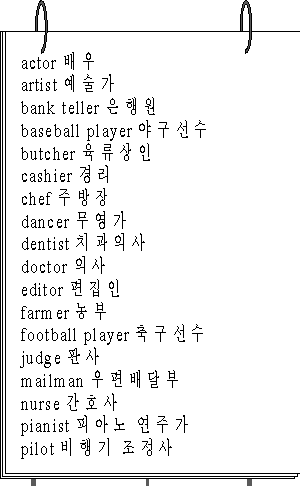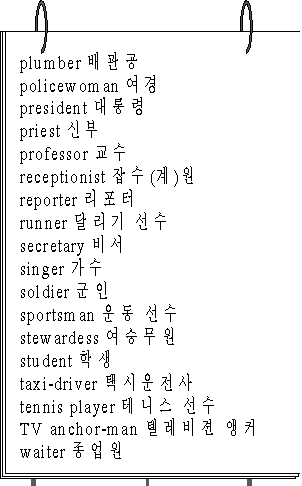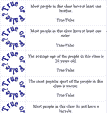
As noted before, all chapters have input on the title page, which students can refer to. In this case the input is family and occupation lexis (the latter being relevant for giving details about members of the family). It is not necessary to "teach" this vocabulary before beginning the activities however, since the activities will focus on this, and the need to review words will arise naturally and meaningfully.
 This is one of a number of "Peer Dictation" activities occurring in the book. The aim is to introduce the topic in an interesting way, and in a manner that helps the students to develop their oral skills. In fact this activity has all four language "skills" (reading, speaking, listening, writing) as well as including aspects of Peer Correction and Classroom Language.
This is one of a number of "Peer Dictation" activities occurring in the book. The aim is to introduce the topic in an interesting way, and in a manner that helps the students to develop their oral skills. In fact this activity has all four language "skills" (reading, speaking, listening, writing) as well as including aspects of Peer Correction and Classroom Language.
The text (Teachers' Resource) is put on a wall, and one member from each group reads it a phrase at a time, and dictates that phrase from memory to the other members of the group. They then use classroom language to arrive at the correct version, which they write on the worksheet.
The second part of this activity asks students to role-play a foreigner and a Korean, the one asking questions, and the other explaining about the the first birthday custom.
Traditionally, in a Korean home the head of the family was regarded as the source of authority. All family members were expected to do what was ordered or desired by the family head. Obedience to the superior was regarded as natural and one of the most admirable virtues. On the other hand, it was understood that the patriarch of the family would be fair in dealing with the family members.
 This activity reviews language from Chapter 1, as well as introducing new family-related questions. Students are once more asked to take on a role, and to follow it through. In this case, they are given some information (Teachers' Resource), which they have to use (along with information they gather from other people in the class) in order to find out who the other members of their assumed family are. These names are then written on the worksheet.
This activity reviews language from Chapter 1, as well as introducing new family-related questions. Students are once more asked to take on a role, and to follow it through. In this case, they are given some information (Teachers' Resource), which they have to use (along with information they gather from other people in the class) in order to find out who the other members of their assumed family are. These names are then written on the worksheet.
Students are once more encouraged to interact with members outside their immediate group, setting the scene for later interview and questionnaire-type activities.
 This activity asks students to write some ideas about themselves in English. There are a number of opportunities for self-study in the book, but the policy regarding the setting of homework is mostly left to individual teachers, who will have their own ways of developing the materials, and their own priorities in terms of student input/output.
This activity asks students to write some ideas about themselves in English. There are a number of opportunities for self-study in the book, but the policy regarding the setting of homework is mostly left to individual teachers, who will have their own ways of developing the materials, and their own priorities in terms of student input/output.
The students introduce themselves to the teacher, and attach a photo of themselves. The textbook has many such "workbook" pages that can be very informative to the teacher.
In this respect, the teacher might consider taking on the same goal as that prescribed for the students - talking about him/herself in a second language, at the end of the sixth chapter!
 There are two activities on this page. The first one is a "Matching" game. Students get together in two teams, with an additional "Caller". Students in Team A choose two numbers: the first from 1 to 10; the second from 11 to 20. The Caller reads out the sentences corresponding to these numbers on the "Callers' Sheet" (see below). If the two sentences match (Question and Answer), the team gets one point, and has another turn. If not, the next team chooses two sentences.
There are two activities on this page. The first one is a "Matching" game. Students get together in two teams, with an additional "Caller". Students in Team A choose two numbers: the first from 1 to 10; the second from 11 to 20. The Caller reads out the sentences corresponding to these numbers on the "Callers' Sheet" (see below). If the two sentences match (Question and Answer), the team gets one point, and has another turn. If not, the next team chooses two sentences.
Students will use various means to remember the sentences. This is fine, since they will be finding ways of dealing with a language problem - how to remember what has been said. In the second version of the game (most students should be able to get to this), they can be encouraged to use only their listening skills!
"Correct" responses are fairly well defined in the first game, but the second set of questions has a number of possibilities. For instance: "Why didn't you come?" could be answered by "I had to wash my hair." or "We went to a movie."; and "Who did you see?" could be answered by "Jennifer" or "My friend." It is not necessary for the teacher to do more than to be aware of these possibilities, for if the students notice them, it will indicate that they are participating in the activity, using their listening skills, and actively evaluating the text.
The prevalence of "games" in this chapter will raise for the students the issue of the validity of interactive activities, in terms of "actually learning anything". In their experience of teaching-learning methodology so far, such things will have been relegated to the ends of chapters, after the "real work" has been done. This is an opportunity therefore to bring this matter into the open, and to show the students that the best way to learn to speak is to participate fully in speaking activities.
 This activity is based on the game "What's my line?". One student performs actions characteristic of an occupation, and the others (in two teams) have to guess what that occupation is. At a basic level the game can continue until the correct answer is guessed, but interest can be added by giving each person a limit of three questions. After that each team must choose what it thinks the occupation is.
This activity is based on the game "What's my line?". One student performs actions characteristic of an occupation, and the others (in two teams) have to guess what that occupation is. At a basic level the game can continue until the correct answer is guessed, but interest can be added by giving each person a limit of three questions. After that each team must choose what it thinks the occupation is.
A preliminary Matching exercise is provided in order to establish the names of various jobs in English (see the next page of this book for the answer key).


 This activity is a simple review of "Can you?", but hopefully the format makes it an interesting one!
This activity is a simple review of "Can you?", but hopefully the format makes it an interesting one!
The teacher gives each group a set of "Can you?" cards (Teachers' Resource), which is put on the board, face down. Students roll a dice and move a counter around the board, using the verb of the square they land on to answer a "Can you?" question about a card (e.g. "Can you lift a bus?"). If they answer "Yes, I can.", they keep the card, and roll the dice again. If they answer "No, I can't.", the next person rolls. The winner has the most cards at the end of the game.
A number of questions will be strange or funny (e.g. "Can you cook a radio?") but this will add to the interest. If students answer "Yes, I can.", then the others will challenge them to explain (in English!).
 Prepositions are a difficult aspect of English, and one which students often see as confusing and important. This book therefore spends some time on these, since they are relevant to the "real-life" situations of giving directions and instructions. By showing the students that there are guidelines, and that they can communicate successfully by following these, it is hoped that their self-confidence will improve.
Prepositions are a difficult aspect of English, and one which students often see as confusing and important. This book therefore spends some time on these, since they are relevant to the "real-life" situations of giving directions and instructions. By showing the students that there are guidelines, and that they can communicate successfully by following these, it is hoped that their self-confidence will improve.
This activity checks on prepositions of location, and leads on to the next one (next page). It can be done in class, or as a preparatory homework.
 Further activities on Prepositions of location.
Further activities on Prepositions of location.
Games 1 & 2 use the "Spot the Difference" format, while game 3 gets the students involved in a memory game, either in teams or pairs. Objects are put on the table (any classroom/personal items will suffice) for the opposing student(s) to look at for 30 seconds. The items are then rearranged, and those students have to put them back in the original locations.
This activity (game 3) can easily proceed without any speaking, so it would be good if (perhaps after the students have become familiar with the game) the teacher mentions that the opposing students are not allowed to touch the items. They must tell the others where to move them (in English!).
 Questionnaire activity. Use of Comparatives.
Questionnaire activity. Use of Comparatives.
Students have to fill in their own choices for the given comparisons, and then to ask at least three people for their opinions, finally reporting their findings to the group or the class as a whole.
This is a chance to look at "Me too", "So do I", "Me neither", and "Neither do I", as well as the responses which occur when participants disagree: "Oh, I do(n't)."

In more information-gathering, students have to ask everyone in the class about one topic, this time an aspect of their daily routines. Having found out how many people do or do not conform to the statement on the card, students have to decide whether that statement is true or false, and then they have to report that finding to the class.
Blank cards are supplied for students who finish early, and who can be asked to make up their own survey questions.
 As with all chapters, the "final" activity is designed to encourage students to discuss the main topic in English. This need not happen solely at the end of the lessons of course, but can occur when appropriate.
As with all chapters, the "final" activity is designed to encourage students to discuss the main topic in English. This need not happen solely at the end of the lessons of course, but can occur when appropriate.
10 minutes is suggested for this activity at this time, since while it is important that students develop all the skills necessary for free talking, uncomfortable silences can be counterproductive, and the activity must last only so long as it is effective. The use of simple questions about the picture will hopefully stimulate some response from every student.
Next Chapter of the Teacher's Notes
Links to the Students's Book
Contents | 1 | Skills | 2 | 3 | 4 | 5 | 6 | 7 | 8 | 9 | 10 | 11 | 12 | Extra
Tell Me More - Task-based Conversation Activities
By Andrew Finch and Hyun Tae-duck
http://iteslj.org/t/tmm/